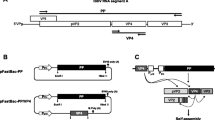Summary
Large plaque (LP) and small plaque (SP) variants of Infectious Bursal Disease Virus (IBDV) which are formedin vitro after serial passages in CE-cells at low or high multiplicities of infection were tested for their pathogenic properties in susceptible chickens. LP virus caused clinical manifestations and destruction of the Bursa of Fabricius (BF) without killing the animals. No signs of a disease appeared after infection with SP virus, and only limited necrotic foci developed in the BF. Coinfection with the SP variant and the highly pathogenic wild type (wt) virus reduced mortality and the severity of the disease. In contrast to the SP variant, which forms incomplete particles of low density, with one or the other of the two genomic RNA segments missing, the two RNA segments characteristic for IBDV were present in approximately equal amounts in wt particles with a buoyant density of 1.29 g/ml isolated from the BF. In spite of an almost total replacement of one of the two major structural polypeptides with a molecular weight of 32 kd by a 28 kd protein, infectivity in this low density fraction was only slightly reduced. This finding underlines the importance of the type of post-translational modification in lymphoid cells or fibroblasts.
Similar content being viewed by others
References
Cursiefen D, Käufer I, Becht H (1979 a) Loss of virulence in a small plaque mutant of the infectious bursal disease virus. Arch Virol 59: 36–46
Cursiefen D, Vielitz E, Landgraf H, Becht H (1979 b) Evaluation of a vaccine against infectious bursal disease in field trials. Avian Pathol 8: 341–351
Dobos P, Hill BJ, Hallett R, Kells DTC, Becht H, Teninges D (1979) Biophysical and biochemical characterization of five animal viruses with bisegmented double stranded RNA genomes. J Virol 32: 593–605
Follett EAC, Desselberger U (1983) Cocirculation of different rotavirus strains in a local outbreak of infantile gastroenteritis: Monitoring by rapid and sensitive nucleic acid analysis. J Med Virol 11: 39–52
Holland JJ, Kennedy SIT, Semler BL, Jones CL, Roux L, Grabau EA (1980) Defective interfering RNA viruses and the host cell response. In:Fraenkel-Conrat H, Wagner RR (eds) Comprehensive virology, vol 16. Plenum Press, New York London, pp 137–192
Huang AS, Baltimore D (1977) Defective interfering animal viruses. In:Fraenkel-Conrat H, Wagner RR (eds) Comprehensive virology, vol 10. Plenum Press, New York, pp 73–116
Käufer I, Weiss E (1976) Electron-microscope studies on the pathogenesis of infectious bursal disease after intrabursal application of the causal virus. Avian Dis 20: 483–495
Käufer I, Weiss E (1980) Significance of bursa of Fabricius as target organ in infectious bursal disease of chickens. Infect Immun 27: 364–367
Laemmli UK (1970) Cleavage of structural proteins during the assembly of the head of bacteriophage T4. Nature 227: 680–684
Lowry OH, Rosebrough NJ, Farr AL, Randall RJ (1951) Protein measurement with the Folin phenol reagent. J Biol Chem 193: 265–275
Müller H (1986) Replication of infectious bursal disease virus in lymphoid cells. Arch Virol 87: 191–203
Müller H, Becht H (1982) Biosynthesis of virus-specific proteins in cells infected with infectious bursal diseases virus and their significance as structural elements for infectious virus and incomplete particles. J Virol 44: 384–392
Müller H, Scholtissek C, Becht H (1979) The genome of infectious bursal disease virus consists of two segments of double-stranded RNA. J Virol 31: 584–589
Müller H, Lange H, Becht H (1986) Formation, characterization and interfering capacity of a small plaque mutant and of incomplete virus particles of the infectious bursal disease virus (IBDV). Virus Res 4: 297–309
Müller R, Käufer I, Reinacher M, Weiss E (1979) Immunofluorescent studies of early virus propagation after oral infection with infectious bursal disease virus (IBDV). Zbl Vet Med 26: 345–352
Nick H, Cursiefen D, Becht H (1976) Structural and growth characteristics of infectious bursal disease virus. J Virol 18: 227–234
Perrault J (1981) Origin and replication of defective interfering particles. Curr Top Microbiol Immun 93: 151–196
Author information
Authors and Affiliations
Additional information
With 3 Figures
Rights and permissions
About this article
Cite this article
Lange, H., Müller, H., Käufer, I. et al. Pathogenic and structural properties of wild type Infectious Bursal Disease Virus (IBDV) and virus grown in vitro. Archives of Virology 92, 187–196 (1987). https://doi.org/10.1007/BF01317476
Received:
Accepted:
Issue Date:
DOI: https://doi.org/10.1007/BF01317476




